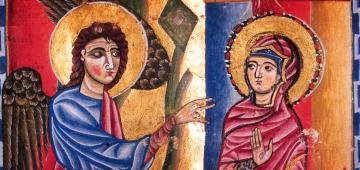
|
|
Trdat (Tiridates) the ArchitectThe video film presents the workings of Trdat the Architect, who erected the Mother Cathedral of Ani - the symbol of ascension and majesty of Bagratid Armenia, and also the stately monuments he created. The film refers to other compositions of Trdat – Argina Cathedral, Gagkashen Church, the gates of Ani serving as a symbol of state power, the specifics of their design and creation, the acrchitect’s innovations and peculiarities of his art. |
 |
Gospel of Haghpat: Markare Illustrator (Tsakhkogh)Haghpat-Ani-Getashen-Etchmiadzin and Yerevan: just like a number of well-known Armenian manuscripts, the Gospel of Haghpat has come a long and poignant road. Created in 13th century in Haghpat Monastery, later illustrated in Ani, in 1920-ies it appeared in Artsakh and from there was brought to Etchmiadzin by Bishop Garegin Hovsepyan. At present, the Gospel is displayed in Matenadaran after Mashtots and presents a unique Armenian manuscript art of Markare Illustrator (Tsakhkogh). |
 |
Toros Taronatsi (of Taron)Plant and geometric decorations. Real and mystical images. Reflecions of folk art and folklore. The minitiarist Toros Taronatsi hears the voices of the outer world and tries to record them. National legends are of great interest to him and they rendered on the pages of the manuscript with fresh interpretations. |
 |
Toros RoslinNew look to the traditional topics, emphasized drama and psychological tenseness of images, expressiveness of feelings and a unique palette. These are the characteristic features of the art of Toros Roslin – the highest peak of Cilician school of miniature. |
 |
Sargis PitsakSargis Pitsak is one of the fundamental representatives of the Armenian book art. His mastery of artistic language is unsurpassable. Due to his images with the power of symbol the Bible and the ritual literature became closer and understandable to the reader, and the unlearned believer was able to communicate to the sacraments of the Scriptures merely for his pictures. |
|
|
MomikMomik is one of the three famous representatives of Gladzor school of miniature. He was born in Vayots Dzor, most likely in the end of 60-ies of 13th century. He lived and created in Syunik. He spent his life in Vayots Dzor, and had children and grandchildren. The biography of Momik Vardpet has been interwoven with lovely legends. Miniature, cross-stone making, architecture: the gifted Vardpet made everything he touched beautiful and blossom; he gave spirit to the manucript and stone, enlivened and magnified the architectural structure passing it to the generations as a stone-made prayer. |
 |
Manuel the ArchitectArchitecture, sculpture, painting: magnificent cathedrals, royal palaces and castles all created through the combination of all arts. 10th Century, political and spiritual uplift and the symbol of that uplift producing Vostan Avan in Aghtamar, Holy Cross Church and a name eternalised forever across centuries – Manuel the Architect. |